Kottayam style fish curry/Meen Mulakittathu
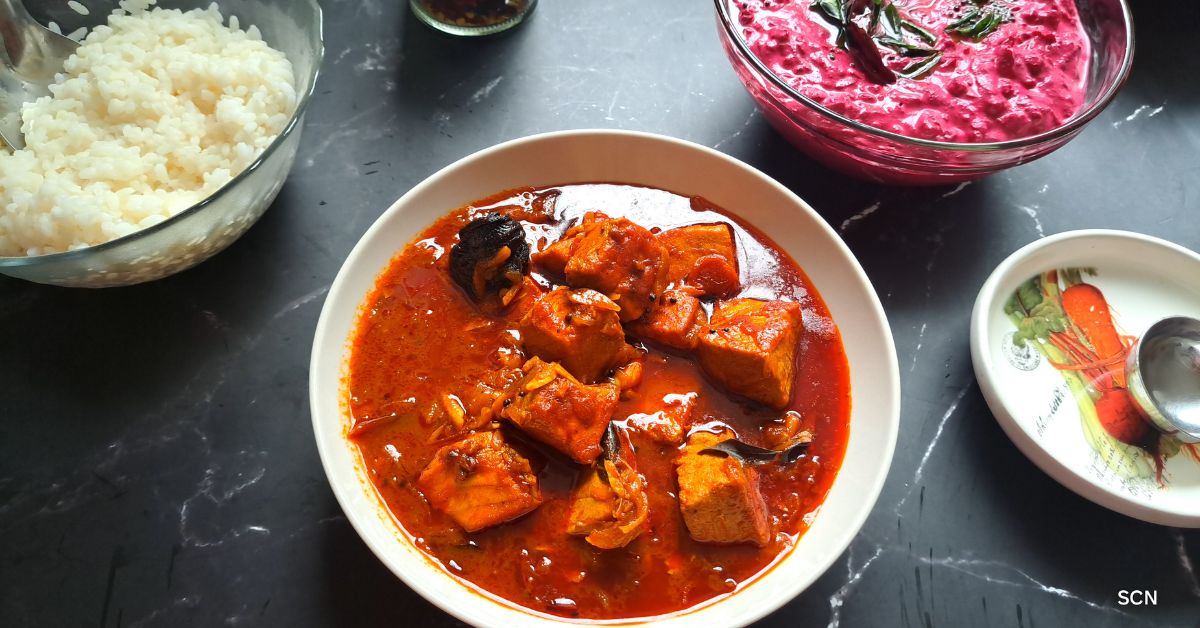
Kottayam style fish curry, also known as “Meen Mulakittathu,” is a traditional dish from the Kottayam region in Kerala, India. It’s known for its bold flavours, rich red colour, and the use of tamarind or kudampuli (Malabar tamarind) to give it a tangy taste. Renowned for its vibrant red colour and bold, tangy flavours, this curry is a staple in many Keralite households. Traditionally, the dish uses firm fish simmered in a spicy gravy. The heat comes from red chilli powder. The distinctive sourness comes from kudampuli, a unique type of tamarind. Served best with steamed rice or Kerala parotta, Meen Mulakittathu is a perfect representation of the rich culinary heritage of Kerala.
The dish features firm, fresh fish—varieties like kingfish, mackerel, or sardines—simmered in a robust gravy. The vibrant red hue comes from Kashmiri chilli powder, adding colour without too much heat. The tangy kick of kudampuli, a Malabar tamarind unique to the region, balances the spiciness. The use of coconut oil, curry leaves, and a blend of aromatic spices like turmeric and fenugreek further enhances the dish, giving it a depth of flavour that is both comforting and exhilarating. Whether paired with steamed rice or traditional Kerala parotta, This curry is a must-try for anyone looking to experience the authentic taste of Kerala.
Kudampuli
Malabar tamarind or Garcinia Cambogia, is a key ingredient in many traditional Kerala dishes, especially fish curries like the Kottayam-style fish curry (Meen Mulakittathu). Kudampuli is a small, pumpkin-shaped fruit that is dried and used in cooking for its sour and tangy flavour.
It has a unique, tangy taste that adds a distinct sourness to dishes. Unlike regular tamarind, which is sweet and sour, kudampuli is more intensely sour with a slightly smoky undertone. When dried, kudampuli turns black and wrinkled. You can soak them in water before adding to the curry to soften and release their flavours. In Kerala cuisine, kudampuli is particularly valued for its ability to cut through the richness of fish, balancing the flavours and enhancing the overall taste of the curry.
If you love flavourful seafood dishes, don’t miss our delicious Fish Molee recipe – a creamy delight!
Love the bold flavours of Kottayam style fish curry? Be sure to check out my Sea Bass Fish Curry recipe—it’s just as delicious and packed with coastal goodness.
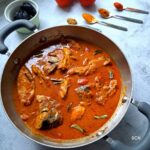
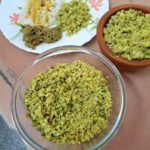
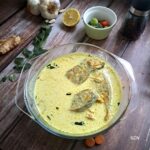

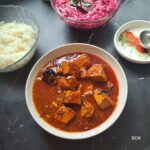
Kottayam style fish curry
Ingredients
- 350 grams of white tuna fish preferably any firm fish like kingfish, sardines, or mackerel
- 3 tbsp coconut oil for authentic flavour
- ½ tsp mustard seeds
- ½ tsp fenugreek seeds
- 2 tbsp Kashmiri chilly powder for colour and mild heat
- ¼ tsp turmeric powder
- ¼ tsp pepper powder
- ½ inch size ginger sliced into julienne
- 5 – 6 garlic cloves sliced into julienne
- 15 Shallots sliced into julienne
- A few fresh curry Leaves
- 2-3 pieces of Kudampuli Malabar Tamarind, soaked in 1/2 cup warm water
- Water as needed for the gravy
- Salt to taste.
Instructions
- Clean and cut the fish into pieces. Set aside.
- Soak the kudampuli in warm water for about 10-15 minutes. Tear it into smaller pieces if needed and set aside.
- In a small bowl combine turmeric, Kashmiri red chilli powder, pepper powder, salt and a bit of water to form a paste. Set aside.
- In a clay pot (manchatti) or deep pan, heat coconut oil.
- Add mustard seeds, and when they splutter, add fenugreek seeds.
- Sauté ginger, garlic, and onions until they turn golden brown.
- Lower the heat and add the masala paste. Sauté the spices for a minute, adding a little water to prevent burning and to cook the spices thoroughly.
- Cook them until the raw smell of the spices is gone.
- Add soaked kudampuli (including the water) to the pan and bring it to a boil.
- Pour in additional water as needed to make the gravy. Boil for 3 -4 minutes.
- Gently place the fish pieces in the curry, ensuring they are covered with the sauce.
- Cover the pot and cook on low heat until the fish is cooked through and the oil rises to the top, which usually takes about 10-12 minutes.
- Add fresh curry leaves and a drizzle of raw coconut oil for extra flavour.
- Let the curry rest for a few hours or overnight for the best flavour, as the spices will intensify.
- This curry is best enjoyed the day after it’s made, as the flavours deepen and meld together. The Kottayam-style fish curry is a delightful combination of spiciness and tanginess, typical of Kerala cuisine.
- Serve hot with steamed rice or Kerala parotta.
Notes
- For the characteristic fiery red colour and spiciness, use Kashmiri chilli powder. You can adjust the heat by combining it with regular red chilli powder or reducing the amount.
- When adding the spices, lower the heat to prevent them from burning. Cooking the spices in oil releases their full flavours and prevents a raw taste in the curry.
- Traditionally, this curry is cooked in a clay pot (manchatti), which enhances the flavour. If you have one, use it, but a regular deep pan will also work.
- Kottayam-style fish curry tastes even better the next day as the flavours have time to deepen. If possible, make the curry in advance and let it rest for a few hours or overnight.
Frequently asked questions
Kottayam-style fish curry, also known as Meen Mulakittathu, is a spicy and tangy fish curry from the Kottayam region in Kerala, India. It is known for its deep red colour, intense flavours, and the use of tamarind (kudampuli) for sourness.
You can use any firm and fleshy fish like kingfish, mackerel, sardines, or even seer fish. These types of fish hold up well during cooking and absorb the curry’s flavours beautifully.
Kudampuli, also known as Malabar tamarind or Garcinia Cambogia, is a souring agent traditionally used in Kerala cuisine. If you can’t find kudampuli, you can substitute it with regular tamarind or even lemon juice, though the flavour profile will be slightly different.
Kottayam-style fish curry is known for its spiciness, largely due to the use of red chilli powder. However, the heat level can be adjusted by using less chilli powder or opting for a milder variety like Kashmiri chilli powder.
You can store the curry in the refrigerator for 2-3 days. It often tastes better the next day as the flavours have more time to develop.
You can serve them with steamed rice, Kerala red rice, or traditional Kerala parottas. It can also be paired with appam or idiyappam for a complete meal. For a complete meal, serve it with side dishes like thoran or a simple vegetable stir-fry.
Yes, You can make Meen Mulakittathu fish curry in advance. It often tastes better when it has had time to sit, allowing the flavours to deepen and meld together.
Yes, you can freeze Kottayam-style fish curry in an airtight container for up to a month. Reheat it slowly on the stovetop to retain its flavours and texture.
Discover More Tasty Recipes!

2 thoughts on “Kottayam style fish curry/Meen Mulakittathu”